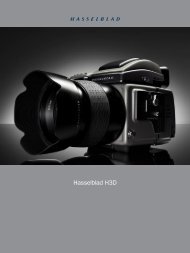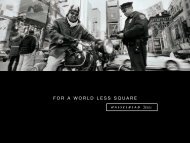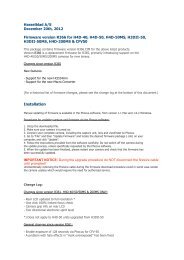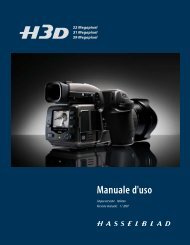VerSATile AS A SWiSS Army knife - Hasselblad
VerSATile AS A SWiSS Army knife - Hasselblad
VerSATile AS A SWiSS Army knife - Hasselblad
- No tags were found...
Create successful ePaper yourself
Turn your PDF publications into a flip-book with our unique Google optimized e-Paper software.
Technology LEnsesVersatile As <strong>AS</strong>wiss army <strong>knife</strong><strong>Hasselblad</strong>’s new superstar lens isn’t even a real lens: The HTS 1.5adapter makes it possible for five HC/HCD lenses to tilt and shift. Plus:a new universal zoom lens, the HCD 4-5.6/35-90 Aspherical now roundsoff the already sizable palette of H lenses.by Hanns W. FriedrichWhat use is the best camera withoutthe best lens? Of course, the lensalone won’t create an image – thedigital age shows us the importanceof sensor technology – but it doesstill provide the foundation for thecamera and software to build upon.The extensive range of <strong>Hasselblad</strong>HC/HCD lenses covers the professionalphotographer’s every needwith nine fixed focal lengths lensesranging from a 28 mm super wideangleto a 300 mm telephoto lens,two universal zoom lenses; the newtilt and shift adapter; one telephotoconverter; extension tubes andimpressive accessories. The result isa complete lens gamut teeming withsolutions for all requirements.Tilt And Shift<strong>Hasselblad</strong>’s new lens champion, theHTS 1.5 is a tilt and shift adapter thatrepresents a real feat of cutting-edgeengineering. H photographers havealways longed for a tilt and shift solutionthat would tilt the focal planeand shift the lens’s optical axis tocorrect convergent lines. The idea todevelop a universal adapter for existingHC/HCD lenses, however, wasa true stroke of genius and one that<strong>Hasselblad</strong> has patented: The convertertransforms five different lensesinto a bona fide tilt and shift. It canbe mounted with the HCD 4/28, HC3.5/35, HC 3.5/50, HC 2.8/80 andHC 2.2/100 and is also compatiblewith <strong>Hasselblad</strong>’s extension tubes.The concept is as simple as it isingenious as the HTS 1.5 is also atelephoto converter, extending thefocal length of a mounted lens by afactor of 1.5. The lens’s image circle isenlarged by that same denominatorand that creates a big enough marginfor tilting and shifting, while alsopreserving the character of the lens.Mounted on the HTS 1.5, the HCD4/28 remains a genuine wide-anglelens with a 71-degree diagonal andcorresponds to a 6.3/45. The shiftcovers up to 18 mm and the tilt upto 10 degrees. Maximum rotationto either left or right measures 90degrees and allows for almost anyform of correction. The adjustmentranges are extensive and allow you toshift by 18 mm up or down and tiltby ± 10 degrees.<strong>Hasselblad</strong> has invested a tremendousamount of technologicalknow-how into the development ofthe HTS 1.5. Every adjustment madeSynopsis• <strong>Hasselblad</strong>s HC/HCD lensescover a wide range of focallengths between 28 and 300 mmand deliver excellent image quality– and so does the new familymember, the HCD 4-5,6/35-90Aspherical, a very universal andcompact wide-angle zoom.• The new HTS 1.5 tilt and shiftadapter transforms five HC/HCDlenses into real tilt and shiftlenses without making compromisesin image quality.• All HC/HCD lenses are optimizedfor all ranges and thanksto DAC they show extremesharpness and no vignetting ordistortion on H3DII cameras.• Numerous accessories – extensionrings, a tele converterand the CF-adapter increase thepotential of the lens program.to the adapter – tilt, shift and rotation– is registered by sensors andsaved in the image meta data. Everyaberration that arises from the opticalsystem as a whole is correctedin the computer software thanks to<strong>Hasselblad</strong>’s Digital Auto Correction(DAC). The photographer canindulge in the HTS 1.5’s wealth ofoptions without having to fear theloss of image quality.What was formerly limited toowners of view cameras with narrowdepth-of-field values is now availableto <strong>Hasselblad</strong> cameras with theirextra-large sensors and outstandingHC/HCD lenses. What’s more – andthis is the key difference – the DACfunction guarantees outstandingimages that are completely error-freeand provides for all the photographicfreedoms you could possiblyimagine. There is no limit to yourcreativity: Correct convergent linesin architecture, shift the focal planein portraiture or adjust the focus andblur on a three-dimensional plane.The HTS 1.5 shines with technicalperfection and it will inspire spontaneityand push you to break the rulesfor interesting effects. It will be availablefrom January 2009. VICTOR’snext issue will take a closer look.HCD 4-5.6/35-90AsphericalThe second innovation in the HC/HCD range – the new HCD 4-5.6/35-90 Aspherical – is a zoom lens thatsets its engineers some very specialchallenges. Zoom lenses can’t affordany weakness, especially when itcomes to high-quality cameras likethe H3DII. On the contrary, theyare expected to substitute for theirfixed-length counterparts withoutadditional constraints. To achievethis, the HCD 4-5.6/35-90 Asphericaltook its makers through unchartedterritory. It’s the first HC/HCD lensever to employ glass elements withaspherical surfaces. Aspherical surfacesare known to provide the lensdesigner with more options, usuallyresulting in more compact designswith fewer elements. However, it wasonly until recently that asphericallenses could be made to the requiredsizes. Compared with the HC 3.5-4.6/50-110, the new zoom lens offersmore wide-angle while being thinnerand about one third lighter.It is the second HCD lens after theHCD 4/28. The ‘D’ alludes to optimizationfor H3D digital cameras whilesimultaneously signifying incompatibilitywith film cameras. To achievecompactness, the lens’s light projectionwas adapted to the ‘48 mmfull format’ sensor of the H3DII-39and -50. At the wide-angle settingin particular, designers balancedimprovements in lens performanceagainst a slightly greater distortionand vignetting as these can be eliminatedwithout quality concessionswith the aid of DAC. The outcome isa powerful tool that zooms betweenan extreme 83-degree wide-angle andjust beyond the fringes of the normallens. Because it is optimized for digitaluse it remains nice and compactand relatively light in weight.Common aspectsAll HC/HCD lenses are tailored todeliver the highest image qualityand fulfill even the most exactingdemands in film and digital photography.They not only compete with<strong>Hasselblad</strong>’s legendary CF lenses forthe V series, they beat them. It wasof utmost importance to <strong>Hasselblad</strong>that the HC/HCD lenses deliver highestperformance not only at infinitybut also at close range, where theyare most frequently used.The patented central shuttermechanism inherent in HC/HCDlenses operates to extreme precision.The fastest shutter speed of 1/800 secondis on point and well within theaccepted ISO specifications. Thanksto 100 percent electronic control, theThe ingenious HTS 1.5 tilt andshift adapter enables you to tilt by±10 degrees or shift by ±18 mm.You decide whether you want tobe well-behaved and use it forperspective corrections or breakthe rules and place the focal planein unexpected positionsThe new HTS 1.5 tilt and shiftadapter transforms five HC/HCDlenses into real tilt and shiftlenses, maintaining their exceptionaloptical performance andbroadening the creative freedomfor the photographer36 Special/2008
Technology LensesHCD 4/28: The 28 mm super wideanglelens is only designed fordigital H cameras and boastsa spectacular 95 degree angleof view mounted on an H3DII-39or -50, and a sizable 89 degreeangle on the H3DII-31. Its closeup performance is outstanding –the subject can be as close as 10cm from the front lensHC 3.5/35: The HC 3,5/35 mm lensis still considered super wide-angle.Mounted on the H2F it reachesan 89 degree angle of view; in conjunctionwith the 48 mm full formatit covers 82 degrees. It’s a powerfullens for creative photography thatis also easy to useHC 3.5/50: The 50 mm lens forH3DII users represents the equivalentof a 35 mm universal lens in35 mm photography. It’s a wideangle that offers ample perspectivewithout seeming unnatural,making it the classic lens in reportagephotography. The universalHC 3.5/50 makes a stand with highperformance valuesHC 2.8/80 : The term ‘normal lens’sounds a little derogatory in thecontext of high-class lenses. Butthe HC 2,8/80 is not only the mostaffordable but also one of thebest HCs in the market. It’s a highspeedlens that sports a luminousviewfinder image along withthe ideal conditions for low lightphotography. The 2.8/80 is alsoexceptionally compact, making itan excellent choice for light-weightphotography outdoorsHC 2,2/100: The compact 100 mmis the fastest HC lens of all, ideal foraction photography and low lightphotography outside the studio.Its slight telephoto effect and extremelylow depth of field makes itideal in portraitureTrue Exposure feature of the H cameraswill automatically correct anydeviations from the actual shutterspeed when the lens is set to smallaperture values. All shutter speeds aremore, the Phocus software permitsyou to activate and deactivate theautomatic controls for vignetting,distortion and chromatic aberrations.When you check the extentCF lens adapter: The CF adapterallows all lenses from the V systemto be used on H system camerabodies and correctly uses the centrallens shutter of the V lenscompatible with flash systems andof the corrections you discover justgrant the photographer total controlhow nominal they are – and yet theyover the lighting, enabling him torepresent that final polish.allows for DAC in the first place andcapture fast action without distor-Whenever highest quality is therepresents just another branch intion and suppress ambient light tohighest priority, lens builders are<strong>Hasselblad</strong>’s drive to perfection. DAChis specifications.forced to compromise the designis what enables all HC/HCD lensesin some form or other. With strongto generate virtually perfect resultsDigital autocorrectionwide-angles, for example, a completeomission of distortion would entaila huge front lens that no companythroughout all aperture settings,ranges and focal lengths, and even incombination with extension tubesAll HC/HCD lenses are designed towould be able to produce and noand converters.generate the highest optical qualityphotographer would want to trans-Photographs are devoid of coloreven on film. Aberrations, which theport – not to mention pay for. Thefringes, crooked lines and black-DAC function is designed to elimi-total exclusion of chromatic aberra-ened corners. <strong>Hasselblad</strong> is spendingnate, are so minuscule they onlytions at all ranges, aperture settingsconsiderable resources to developbecome visible with the extremeand focal lengths is simply out of thecorrective algorithms based on lensresolution of H3DII cameras. What’squestion. Only tiny aberrations candesign and apply them universallybe corrected digitally without thwart-to all lenses, independent of possibleing the quality of the reproduction.fluctuations in manufacture. ThisHCD 4-5.6/35-90: The all new HCD4-5.6/35-90 adds a gorgeous wideanglezoom to the line of HC/HCDlenses. With its 82 degrees angleof view on the wide end and a mildtelephoto effect on the other, it’sas universal as a Swiss army <strong>knife</strong>.Thanks to its compact size andmoderate weight, it’s the perfectoutdoor companion for the H3DIIDigital corrections will never transforma mediocre lens into a goodlens. It can however, turn a great lensinto a perfect lens. DAC is extremelyvaluable when used with the newHTS 1.5 adapter since now you canreally shift into the outer corners ofthe HC/HCD lenses and push themunto limit. The H3DII is founded ona concept of integration: It’s whatcan only be done because the tightmanufacturing process of the lensesguarantees few deviations from theideal values. Unlike other professionalcamera manufacturers, <strong>Hasselblad</strong>takes into account the availability ofDAC at the design stage of HC/HCDlenses. The HCD 4/28, for example,allowed for distortion values that areslightly above average and yet easily38 Special/2008
HC 4/120: The HC 4/120 is a classicmacro lens that reaches a 1:1 reproductionscale without addingextension tubes. Its optical excellenceand its versatility gives itan almost legendary standingamongst H photographers. It is aclassic portrait focal length thatcan be used for far more than justclose-up photographyHC 3,2/150: Thanks to highspeed and moderate telephotoeffect the HC 3,2/150 is a finechoice in classic portraiture –and a prime choice in landscapephotographyHC 4/210: The counterpart tothe classic 135 mm lens in 35 mmphotography comes in the formof the HC 4/210 – a classic telephotolens with outstanding performancestatistics. The 210 mm iseffective in both portraiture andlandscape photography, generatingthat slightly compacted, typicaltelephoto perspectiveHC 4,5/300: The ‘longest’ telephotolens in the H series is ideal forwildlife and sports photography,where it draws even the shiest ofmammals and energetic of actionsup close. Mounted in conjunctionwith the H1.7X converter the lensmutates into a beastly 500 mm ofexceptional qualityHC 3,5-4,5/50-110: Zoom lensesare easy to use and practical,enabling you to quickly respond tochanging conditions. The HC 3,5-4,5/50-110 covers an invaluablephotographic spectrum rangingfrom slight wide angle to portraittelephoto. As a zoom it has noproblem keeping up with the speedand reproduction values of fixedfocal lengths. Its versatility is whatmakes it one of the most popularHC lenses of allH System vs. 35 mm lensescorrectable. Chromatic aberration,in turn, is prevented almost entirely.To design a ‘digital’ lens with similarperformance statistics – but withoutDAC – would require tremendouseffort. Thanks to DAC, however, theHE extension rings: Availablewith 13, 26 and 52 millimeters,the HE extension ringsallow macro photography withall HC/HCD lensesConverter H1.7X: The convertercan freely be combined with allHC/HCD lenses except the wideangles and zooms, vastly increasingtheir range of useObjektiv Diag. angle of view Diag. angle of view Diag. angle of viewH3DII-39 and -50 H3DII-31 H2F w. 645-film(35 mm focal length) (35 mm focal length) (35 mm focal length)HCD 4/28 93° (20 mm) 87° (23 mm) –HC 3.5/35 81° (25 mm) 75° (28 mm) 87° (23 mm)new super wide-angle remains smallHC 3.5/50 63° (35 mm) 58° (39 mm) 68° (32 mm)and compact and, not least, moreaffordable. Similarly for the HTS 1.5tilt and shift adapter that withoutDAC wouldn’t permit all combi-in practice. The table on the right displaysthe HC/HCD lenses alongsidewith their 35 mm counterparts.In addition to the HC/HCD lensesextends the range of HC/HCD lensesat the telephoto end with the exceptionof the wide-angle and zoomlenses. For close-ups there are the HEHC 2.8/80 41° (58 mm) 37° (64 mm) 45° (52 mm)HC 2.2/100 34° (71 mm) 31° (78 mm) 38° (64 mm)HC 4/120 29° (84 mm) 26° (93 mm) 32° (75 mm)nations to be adjusted for withouterrors. In other words, DAC is essentialto the production of innovativeproducts such as the HTS 1.5 or theon these pages, <strong>Hasselblad</strong>’s lensgamut holds several other specialtiesin stock, such as the CF adapterfor compatibility with the legend-extension rings with 13, 26 and 52mm lengths. Depending on the lens,the extension tubes and converterscan be combined with each other,HC 3.2/150 23° (106 mm) 21° (118 mm) 26° (95 mm)HC 4/210 17° (149 mm) 15° (165 mm) 18° (134 mm)HC 4.5/300 12° (206 mm) 11° (229 mm) 13° (186 mm)HCD 4/28. The best thing about DACary Zeiss lenses of the V system. Theand, apart from a few exceptions,HCD 4-5.6/35-90 81–39° (26–61 mm) 75–35° (26–68 mm) –is its transparency: the photographerhas only to press the exposure buttonH camera’s autofocus mechanismallows for sublime focus control andthe AF function remains operational.Since the converters and extensionHC 3.5-4.5/50-110 62–32° (36–76 mm) 56–29° (40–85 mm) 67–35° (33–69 mm)and convert the photo in Phocus tothe camera’s exposure meter displaystubes are fully integrated in DAC theyremove all aberrations automatically.the speed and aperture to be trans-can be used without restriction. Theto resurrect their old view cameras orto macro and from universal zoom toIn theory, with the right amount offerred to the lens. In the case of CFEHC/HCD’s outstanding performanceperhaps even setting for lower-qual-a specialized tilt and shift solution.craftsmanship and willingness tolenses, the aperture setting is trans-statistics will be preserved from closeity solutions from the 35 mm market.There’s bound to be the right lens forexperiment you could limit errorsferred to the camera. The CF lensrange to extended telephoto.The temptation of being able to useeveryone. And the strength of thelike vignetting, and even distortion,adapter greatly expands the range ofthe outstanding HC/HCD lensessystem isn’t only in its vast portfoliousing Photoshop. But Phocus withDAC delivers the optimal solutioncompatible lenses for H3DII users;take the 500 mm CF lens, for exam-CONCLUSIonwith tilt and shift functionality,fused with cameras with impres-and complete coverage of needs; it’sthe reliability with which HC/HCDautomatically.ple, which currently lacks an equal inThe palette of HC/HCD lenses couldsively large image sensors, is beyondlenses are known to deliver highthe H system. CF lens users may nothave be considered complete sinceseductive. The new zoom, in turn,performance across the board. AndSpecialitiescall upon DAC yet, but it doesn’t stopthese renowned lenses from livingthe introduction of the HCD 4/28.Now, however, the HTS 1.5 tilt andis as universal as a Swiss army <strong>knife</strong>and may cover all your photographicthis is what counts: tools that alwayswork, never abandon you and alwaysThe H3DII-31’s slightly smaller sen-up to their outstanding reputationshift adapter and the new HCD 4-needs all by itself. <strong>Hasselblad</strong> cov-make the most of your possibilities.sor yields a 1.2 crop factor. That’s notwhen mounted on the H3DII.5.6/35-90 Aspherical expand theers with the HC/HCD lenses a veryenough to really change the characterThe offering is made completerange even further. The HTS 1.5 nowbroad range from super wide-angleFor further information please visitof a lens and rarely poses a problemwith the Converter H1.7X. It largelyspares <strong>Hasselblad</strong> users from havingto super telephoto, from ‘light giant’www.hasselblad.comSpecial/200839












